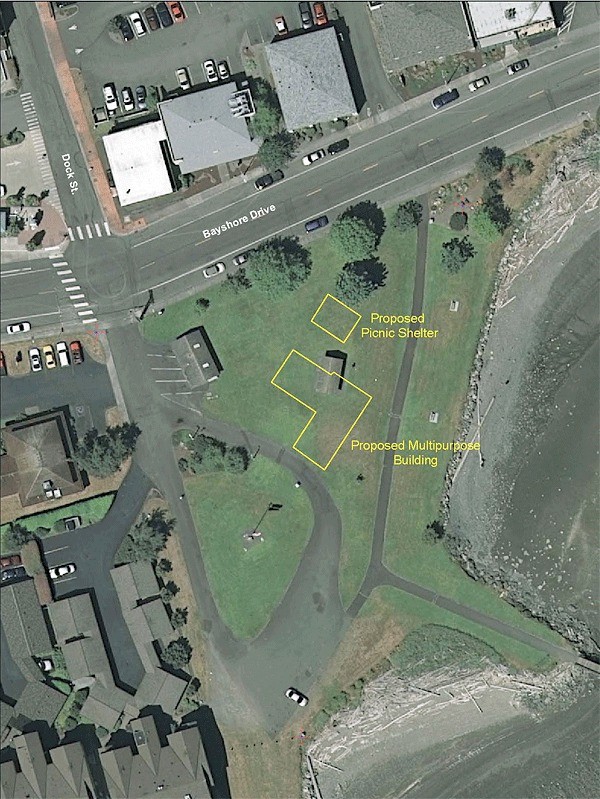A pier-less pier project proposed for Flintstone Park on Oak Harbor’s waterfront may have been permanently sunk this week.
Following public outcry, along with strong warnings from one city department head, the city council Tuesday voted unanimously to scrub the project until certain funding concerns are resolved.
“It doesn’t make sense to move forward on a project that doesn’t financially make sense,” Councilman Scott Dudley said.
Before the council Tuesday was the consideration of a shoreline development permit for planned improvements at the small waterfront park. The proposal is to replace the existing picnic shelters and bathrooms with a 2,325-square-foot multipurpose building, a 525-square-foot picnic shelter, plaza, trail improvements, paved parking and a circular drive.
Dubbed the Multimodal Facility Project, it’s the latest machination of a longtime effort to replace the historic Maylor Dock with a municipal pier. Built in the late 1890s, the structure played a vital role as it provided a place for large ships to tie up and offload goods and supplies.
The structure was still in use in 1966 when it was destroyed by fire. There was talk for years of rebuilding the dock, but it wasn’t until the late 1990s and the establishment of citizen-based planning group that the effort really took off.
The idea was to use the pier for passenger ferry service.
The city spent years on the effort, paying for consultants and studies that identified everything from possible uses to alternative locations. The process got so far along that the city acquired many of the permits needed to build the over-water structure.
But the project hasn’t gone anywhere, largely due to lack of funding, and the 2003-issued permits have since expired. The city had been hoping to pay for the structure, which in 2007 was estimated at $11.8 million, with federal grant money, according to Development Services Director Steve Powers.
But while the funds needed for the whole project remained elusive, the city was able to secure a handful of grants, including $836,000 in federal transportation money. Making sure that grant doesn’t go to waste is a primary driver for the proposed multimodal facility, Powers said.
But the evolution of the project has proved unpopular with some Bayshore Drive residents and business owners. Seven people spoke against the project, urging council members to reject the permit. One of the biggest concerns hinged on view obstruction caused by a new building.
“Location, location, location,” Carla Dozier said of her decision to open a business nearby over 25 years ago.
“That’s my view, that’s my front yard,” she said.
Others, particularly residents who live in nearby condos, said they were worried that noise from public use of the facility would rival that of a nearby nightclub. Another complained that the building is designed to accommodate 90 people while only 12 parking spaces are planned.
Issues such as long-term maintenance, possible impacts from the recent discovery of bones on SE Pioneer Way and the overall sensibility of the project were also broached. Paul Brewer, a city council candidate, argued that it makes little sense to proceed when the larger project is going nowhere.
“The project is dead, it’s dead,” Brewer said.
He urged the council to return the federal grant, saying it wasn’t right to the spend money because it was secured to build a “ferry ticket booth” for a pier project, not the multimodal facility being proposed.
Brewer wasn’t the only one worried about the grant funds. City Finance Director Doug Merriman had enough concern that he declined to sign off on the agenda item before the council.
Agenda items always receive the initial of the major and other senior city leaders. The purpose is to show council members that items hav been reviewed and approved. In this case, Mayor Jim Slowik, City Administrator Paul Schmidt, and City Attorney Margery Hite all signed off on the permit.
Although the council was only being called on to approve a shoreline development permit, not the building project itself, Merriman said there are enough problems with the grant that he believed it warranted immediate discussion.
“I don’t want to wait until we’re ready to pull the trigger,” Merriman said.
The building was originally estimated to cost about $1 million but he said that number has since inflated to $1.4 million. That means the city’s planned $209,000 contribution will increase to about $600,000 and there has been little discussion by staff of where that money will come from, he said.
The city may also be on the hook for three other grants received between 2001 and 2006. Totaling $493,000, they were spent on design and engineering for the pier project. But because they were awarded specifically for a ferry-focused pier, the funding may have to be returned, Merriman said.
Fortunately, he anticipated that might happen and has been putting away a little money every year since 2002. Having saved $220,000, the city would still have to come up with another $273,000. Added to the $600,000, the end cost for the multimodal facility would hit $900,000, Merriman said.
Although there was quite a bit of discussion among council members, it was ultimately agreed that the financial concerns were too great to ignore.
The shoreline permit, and overall building project, would have to wait until those questions are satisfactorily answered.
Development Services Director Steve Powers said the plan had been to ask the council to approve sending the project out for bid next month but that will now likely have to be pushed back until September, if it’s done at all.



